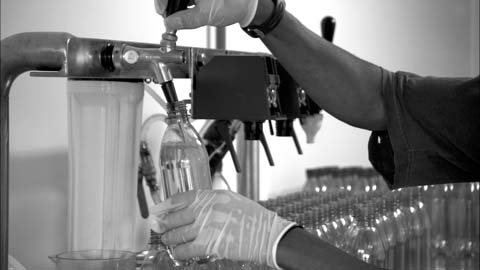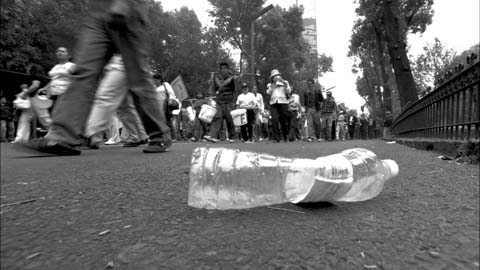Chapter 4
By Eugene F. Provenzo, Jr. and Cory A. Buxton
Bottled Water: A Good or Bad Thing?

| Bottled Water: A Good or Bad Thing | |
| SC.A. 1.2.1 | The properties of materials (in this case, taste) can be compared and measured. |
|---|---|
| SC.D. 2.2.1 | Reducing, reusing, and recycling natural resources improves and protects the quality of life. |
| SC.H. 1.2.2 | A successful method to explore the natural world is to observe and record, and then analyze and communicate the results |
Bottled Water: A Good or Bad Thing?

Bottling water creates the additional problem of disposing the used plastic containers.
Throughout the world, bottled water has become enormously popular in recent years. Besides its convenience, bottled water is often thought to be purer and better tasting than tap water from municipal sources. Much of this perception is a result of advertising which emphasizes the idea that bottled water comes from crystal clear mountain springs or the run-off of pure glacial water. This “exotic” water comes in designer bottles that are often prominently displayed by restaurants, catered events or by people proclaiming their “good taste.” Research by groups such as the Natural Resources Defense Council, however, suggests that the bottled water sold in the United States is not necessarily purer or safer than most tap water. In a four-year study, the NRDC tested over 1,000 bottles of 103 different bottled water brands. They concluded that there was no significant difference in the content of municipal tap water versus bottled water.
Does bottled water taste better than municipal tap water? The following activity will have you test the hypothesis that bottled water tastes better than municipal tap water.
Have students consider the following summary question:
Why do you think people buy bottled water (other than the fact that it is convenient)? Are there ways we could carry drinking water with us without having to buy a bottle of it each time we need a drink?
Activity: Does Bottled Water Taste Better
In the following activity you will have people sample bottled water and municipal tap water and determine which tastes the best.
Materials Needed
- a large bottle each of two different samples of tap water collected from different places in the community (such as one from a school water fountain and one from home)
- a large bottle each of three different brands of bottled water
- small paper cups (five for each person participating in the test)
- copy of Water Taste Sample Activity Worksheet
To conduct the taste test, follow the steps below:
- Remove or totally cover the labels on each bottle (note that if one or more brands of the bottled water comes in a bottle of unique shape, color, etc., the water should be transferred into a more generic bottle).
- Using a permanent marker, number the bottles from 1-5 making sure that you have recorded which water sample is in which bottle.
- Give each student five small paper cups and have them number the cups 1-5.
- Pour a small amount (1-2 ounces) from each bottle into the students’ cups, making sure to match the bottle number to the cup number.
- Using the Water Taste Sample Activity Worksheet, have each student conduct the water taste test.
- Tally the results and then construct a bar graph. How do the commercially bottled waters compare with the tap water samples? If the results of the research of the Natural Resources Defense Council described at the beginning of this activity are accurate, your results should be largely random.
Consider the Quote
“I have always been a big advocate of tap water—not because I think it harmless but because the idea of purchasing water extracted from some remote watershed and then hauled halfway round the world bothers me. Drinking bottled water relieves people of their concern about ecological threats to the river they live by or to the basins of groundwater they live over. It’s the same kind of thinking that leads some to the complacent conclusion that if things on Earth get bad enough, well, we’ll just blast off to a space station somewhere else.”
—Sandra Steingraber, Having Faith, 2001
Exploring One Water
How does the bottling of water use valuable resources? Does the use of bottled water potentially contribute to the polluting of our environment? Look at the “bottling” clip from the One Water video library. What does it suggest to you about the cost of bottled water? What is a bottle of water when you remove the bottle? Where does it come from? What is the water’s real cost?
Extension Activities
Having students become aware of where water resources are found in their communities is a first step to helping in its preservation. In the following activities, students should become more aware of where water resources are in their local neighborhoods and where there is water that is polluted and needs restoration.
Elementary School Students
Create a list with students of the different places where water is found in their community (ponds, streams, rivers, lakes, water-processing plants, etc.). Talk with them about which water they would be willing to drink and which is not drinkable. Ask them why there are different types of water (drinkable water, polluted water, fresh water, salt water). Have them complete “cloze” types of sentences, e.g.:
Polluted water cannot be (drunk).
Drinking water must be kept (clean).
Multimedia
Have students draw a picture of the different types of water that are found in their communities.
Middle School Students
Have students map the water resources found in the neighborhood where they live or near the school they attend. Have them determine who controls the water that is in their community. Is it owned by a local municipality? By a private owner? Also have them find out where the water comes from that they use every day. See if information can be obtained from the local water management district’s website. If information cannot be easily found, have them call members of the local water management district to obtain information.
Multimedia
Have students record different sounds of water on a tape or digital recorder. For example, have them record the sound of splashing water, the drip of a faucet, the whistle of a tea kettle. Play the recordings and have students write descriptions of what they hear. Then have them create short, one sentence poems using what they have described. An example of this type of poem could look and sound like this.
E.g.: The water drip………ped, ever sloowwwwwwwwwwwly out of the tap
Grade School Students
Have students research the production of the following commercially bottled waters and determine how far each bottle has to travel if it is to be sold in a store in Omaha, Nebraska (approximately the middle of the United States).
- Aqua Fiji, bottled in the remote highlands of the Pacific Fiji Islands
- Arrowhead Mountain Spring Water, bottled on the slopes of the San Bernardino Mountains in California
- Hawaiian Spring Water, bottled on the slopes of Mauna Loa Volcano in Hawaii
- Virga Pure Tasmanian Water, bottled water from the island of Tasmania, Australia
Multimedia
Have students create a presentation or a film for YouTube or some other public site documenting the distance and resources involved in transporting any of the bottled waters from the point where they are taken from the Earth to the point where they are purchased in a store in Omaha, Nebraska . Have them describe the resources consumed in delivering the water, starting with plastic for the bottle, the gasoline to fuel the transportation for shipping the water, the “carbon footprint” of the product, etc . Students may wish to research the above companies or other water bottling companies to discover how they transport water, what it costs, and so on.
